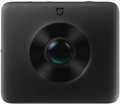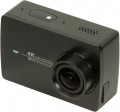Product type
—
Action camera. In other words, all models that are not panoramic or 360° cameras (see below). Note that in some models, the viewing angle can be 180 ° or even more. The difference from panoramic cameras in such cases is that action cameras do not shoot panoramas.
—
Panoramic camera. A type of action camera designed for shooting panoramic photos and videos. A distinctive feature of this type of camera is the fisheye lens protruding from the body. Such a lens completely covers the hemisphere in front of it, which provides interesting additional features: for example, by installing such a camera with the lens up under the windscreen of a car, you can capture both what is happening on the road and the behaviour of the driver and passengers at the same time. When viewing ready-made panoramas, the user can shift the image at will, directing his gaze in any direction within this hemisphere (this applies to both photos and videos); also similar photos and videos are well suited for viewing in virtual reality glasses.
—
360° camera. Further development of the idea of the panoramic cameras described above: devices that have several lenses and can cover the surrounding space completely or almost completely, 360° along any axis. Most 360° cameras are equipped with two lenses on opposite sides of the body. However, there are models with 4 and even 6 lenses (see "
...Lenses" for more details). Anyway, cameras of this type provide maximum coverage but are not cheap.Lenses
The number of lenses provided in the camera.
This parameter in our catalogue is indicated only if there is more than one lens. The most common variety of these cameras are 360° cameras (see "Product type") with a pair of lenses on both sides of the body. In conventional action cameras and panoramic cameras, two lenses can also be provided — in such devices, they are placed on one side of the body and are used for shooting in 3D. Noticeably rarer are other, more specific design options — for example, cameras with 4 or 6 lenses around the circumference of the body.
Dust-, moisture-proof camera
The level of dust and water protection provided by the body of the camera itself. Most action cameras are designed for recording in extreme conditions, but the level of protection of each model can vary significantly — from the ability to shoot in the rain, to full tightness, allowing for a long immersion under water.
To characterize the security level of the camera, the international IP classification is used. Each device is assigned a code of the form IPXX, where instead of the first X — the level of protection against the ingress of foreign objects (including dust), and instead of the second X — the level of protection against the ingress of water.
Levels of protection against dust and foreign objects in modern action cameras are never lower than 5 — lower protection classes would provide unacceptably large gaps in the body. Specifically, level 5 provides that dust can get inside in small quantities, but does not affect the performance of the device. A higher level — 6 — provides full dustproof.
To characterize the level of protection from water, the following classification is used:
0 — no protection;
1 — drops of water falling at a right angle relative to the operating position of the device cannot cause dangerous consequences;
2 — protection against drops falling on the equipment at an angle of up to 15°;
3 — at an angle up to 60° (splash protection, minimum rain protection);
4 — protection from rai...n with strong wind;
5 — protection against water jets falling at any angle (water jets, for example, from a hose or heavy rain cannot harm the device);
6 — from temporary flooding;
7 — from temporary immersion under water to a depth of not more than 1 metre;
8 — from prolonged diving to depth (maximum time and depth are specified by the manufacturer separately).
In some cases, a model may only be IP-certified for one type of protection (only against sand or water). In this case, instead of the second parameter, simply X is put. So, for example, IPX6 security means that the camera is protected from temporary flooding and heavy rain, but the level of protection from dust is not defined and, accordingly, is not certified.
It is important to note that this parameter characterizes the protection of the camera itself, but does not take into account the capabilities of protective cases. Do not confuse it with the protection of the outer case, which sometimes comes with the device (see "Dust-, moisture-proof of case").
HD (720p)
The ability of the camera to record HD video (720p).
The official HD specification provides a resolution of 1280x720. However, in action cameras, there may be resolutions slightly different from this parameter, for example, 1080x720 or 1440x960. Anyway, HD is the most modest of today's high-definition standards, which, nevertheless, provides a fairly clear and detailed image.
Another important parameter given in this paragraph is the frame rate. The higher it is, the smoother the movement in the frame will be, and the details in dynamic scenes will be visible clearly. Technically,
30 fps or even less is enough for video, but
60 fps is considered the perfect value — at this frame rate, motion blur becomes almost imperceptible and at the same time the size of the captured files remains within reasonable limits. However, there are cameras on the market with higher frame rates at HD resolutions —
100 fps,
120 fps,
200 fps and even
240 fps. This speed is usually used for recording slow-motion video, but such a possibility needs to be specified separately.
Full HD (1080p)
The ability of the camera to shoot Full HD (1080p) video.
The standard image size in this standard is 1920x1080. However, in the case of action cameras, this category also includes some other resolutions that are similar in quality, for example, 1440x1080. In general, Full HD provides a very good balance between image quality, the volume of captured files and the processing power requirements for processing them, which makes this standard very popular in modern video equipment — both in cameras and in TV monitors.
Another important parameter given in this paragraph is the frame rate. The higher it is, the smoother the movement in the frame will be, and the details in dynamic scenes will be visible clearly. Technically,
30 fps or even
less is enough, but
60 fps is considered the perfect value — at this frame rate, motion blur becomes almost imperceptible and at the same time the size of the captured files remains within reasonable limits. However, there are cameras on the market with a higher frame rate at FullHD resolutions —
90 fps,
100 fps,
120 fps and even
240 fps. This speed is usually used for shooting slow-motion video, but the possibility of such shooting needs to be specified separately.
Quad HD
The ability of the camera to shoot QuadHD video.
This standard includes an extensive set of resolutions — from 1440 to 3456 pixels horizontally and from 1440 to 2160 pixels vertically, with almost two dozen intermediate options. It is a rather specific transitional option between the relatively inexpensive FullHD 1080p and the demanding UltraHD 4K, allowing you to shoot higher resolution video than 1080p without significantly increasing the cost of equipment. Note that pure QuadHD resolutions are rare in TVs and monitors, but modern technologies make it possible to comfortably watch videos of this format on any high-resolution screen.
Another important parameter given in this paragraph is the frame rate. The higher it is, the smoother the movement in the frame will be, and the details in dynamic scenes will be visible clearly. For example, a filming speed of
25 fps or
30 fps approximates the standard frame rate in film and television; such an image is quite viewable, but fast-moving objects in the frame will look blurry. With an increase in speed to
60 fps, this effect becomes almost imperceptible. The highest QuadHD frame rate found in modern action cameras is
120 fps; this frequency is used when shooting slow-motion video (as well as models with a frequency of
100 fps) because at a n
...ormal playback speed, 60 fps is enough.Ultra HD (4K)
The ability of the camera to shoot Ultra HD 4K video.
This format covers several resolutions in which the horizontal frame size is approximately 4K pixels. The most popular in action cameras is 3840x2160 (twice the FullHD frame on each side), but there are other options — for example, 3840x1920, corresponding to an aspect ratio of 2:1. In general, 4K is a kind of successor to Full HD: among HD standards that surpass Full HD, UltraHD is the most popular, in particular, many advanced TVs are produced with 3840x2160 screens. On the other hand, this format is quite demanding in terms of processing power and memory, so it is relatively rare in action cameras, mainly among premium models.
Another important parameter given in this paragraph is the frame rate. The higher it is, the smoother the movement in the frame will be, and the details in dynamic scenes will be visible clearly. However, in UltraHD mode, most modern action cameras produce a very low frame rate — most often
30 fps, and in some models
24 fps or even
15 fps. This video is quite viewable, but fast movement in the frame may look blurry. There are cameras capable of shooting UltraHD at a solid speed of
60 fps — the blurring effect during such shooting is almost imperceptible. However, such a model cost is high.
Field of view
For models with several lenses, as a rule, this parameter is indicated for each lens.
Most often (unless otherwise indicated), the specifications indicate the field of view by the diagonal of the frame; in some
ultra-wide-angle lenses it can exceed 180°. A special case is made up of lenses for which a 360° view is declared: this means that the optics cover the entire hemisphere in front of it. Such lenses are found in panoramic and 360-degree cameras (see “Product type”).
In general, the field of view primarily determines what area of the scene is being captured into the frame. Accordingly, the wider it is, the more space the camera captures, and the lower the likelihood that something that is happening will be off-screen. On the other hand, it is worth considering that a strong increase in the field of view leads to distortions of the “picture”, especially at the edges, as well as, to a decrease in the size of visible objects and a decrease in detail. Detailed recommendations regarding choosing a camera based on this parameter can be found in special sources.
Digital stabilization
The presence of a digital (electronic) stabilization system in the camera design.
Any stabilization is intended to compensate for small juddering of the image that occurs due to the instability of the hold in the hands, vibrations from the motor or road roughness (when used in transport), etc.
Digital stabilization is carried out as follows: a reserve area is allocated along the edges of the sensor, which under normal conditions does not participate in the formation of the final image. If the device is being shaken, the camera electronics select certain parts of the image from the reserve and build the image in such a way that in the end, it remains stable.
Compared to other methods of stabilization, digital systems are extremely simple and reliable. Moreover, they are inexpensive and have almost no effect on the weight, dimensions, and price of the camera. At the same time, with this method of stabilization, the effective area of the image sensor is reduced, which can adversely affect the image quality and the amount of noise on it.

